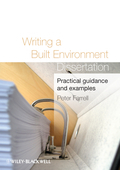
Writing a built environment dissertation: practical guidance and examples
Farrell, Peter
INDICE: Author biography. Preface. 1 Introduction. 1.1 Introduction. 1.2 Terminology; nomenclature. 1.3 Document structure. 1.4 Possible subject areas for your dissertation. 1.5 Qualitative or quantitative analysis? 1.6 The student/supervisor relationship and time management. 1.7 Ethical compliance. 1.8 House style or style guide. 1.9 Writing style. 1.10 Proofreading. 2 The introduction chapter to the dissertation. 2.1 Introduction contents. 2.2 Articulation ordescription of the problem and provisional objectives. 3 Review of theory andthe literature. 3.1 Introduction. 3.2 Judgements or opinions? 3.3 Sources of data. 3.4 Methods of finding the literature. 3.5 Embedding theory in dissertations. 3.6 Referencing as evidence of reading. 3.7 Citing literature sources inthe narrative of your work. 3.8 Secondary citing. 3.9 Who to cite in your narrative. 3.10 References or bibliography or both? 3.11 Common mistakes by students. 3.12 Using software to help with your references. 3.13 Avoiding the charge of plagiarism. 4 Research goals and their measurement. 4.1 Introduction. 4.2Aim. 4.3 Research questions. 4.4 Objectives. 4.5 Objectives with only one variable. 4.6 Objectives with two variables. 4.7 Hypotheses. 4.8 Independent and dependent variables. 4.9 Lots of variables at large; intervening variables. 4.10 Subject variables. 4.11 No relationship between the IV and the DV. 4.12 Designing your own measurement scales. 4.13 Levels of measurement. 4.14 Examples of categorical data in construction. 4.15 Examples of ordinal data in construction. 4.16 Examples of interval and ratio data in construction. 4.17 Money as a variable. 5 Methodology. 5.1 Introduction. 5.2 Approaches to collecting data. 5.3 Types of data. Primary or secondary data. Objective or subjective data; hard or soft. 5.4 Questionnaires. Piloting the questionnaire. Coding questionnaires. A basket of questions to measure variables or multiple item scales. Using a basket of questions in ordinal closed-response scales. Other possible responses in ordinal closed-response scales. Ranking studies. 5.5 Other analytical tools. 5.6 Incorporating reliability and validity. 5.7 Analysis, results andfindings. 6 Qualitative data analysis. 6.1 Introduction and the process. 6.2 Steps in the analytical process. 7 Quantitative data analysis: descriptive statistics. 7.1 Introduction. 7.2 Glossary of symbols. 7.3 Calculations done manually or by using software. 7.4 Descriptive statistics. Ranking. Normal distributions: measures of central tendency (mean, median and mode). Measures of spread: range, standard deviation, variance. Standard score: the Z score. Confidence intervals. General use of descriptive statistics. 8 Quantitative data analysis: inferential statistics. 8.1 Introduction. 8.2 Probability values. 8.3 Thechi-square test. Assembling the raw d
- ISBN: 978-1-4051-9851-6
- Editorial: Wiley-Blackwell
- Encuadernacion: Rústica
- Páginas: 280
- Fecha Publicación: 31/12/2010
- Nº Volúmenes: 1
- Idioma: Inglés
